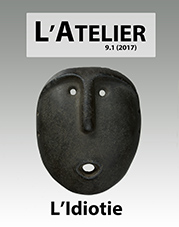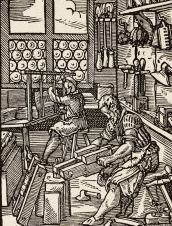Of Divine Idiots and Wise Men: Idiocy in Djuna Barnes’s Nightwood
Mots-clés :
Barnes, Idiotie, Savoir, Roman, PoésieRésumé
Summary:
The figure of the idiot is central to Djuna Barnes’s short 1936 novel Nightwood. It appears in the story in the shape of Felix, Guido, Nora, Robin, Jenny, and least likely of all, Doctor Matthew O’Connor—characters that relate to each other through idiocy. The multiplicity of idiotic characters points to the multiplicity of definitions and modes of idiocy. This reading of Nightwood takes as its point of departure this double multiplicity, and aims at bringing to light a trajectory common to all characters: in seeking knowledge in the figure of the doctor, they resist being defined as idiots, but in this very resistance, they wind up establishing themselves as such. Idiocy is a process by which the characters move towards knowledge all the while, and inevitably, straying from it. By consulting Doctor Matthew O’Connor, who represents both knowledge and cure, the characters turn idiocy into an affliction—a malady of ignorance—of which they want to but cannot be cured. Idiocy, however, goes beyond being an illness, and is not limited to the characters that inhabit Barnes’s novel: it is implied in the very gesture of narration. As a result, the reader also becomes involved in its movement since he or she is made to undergo idiocy. To read Nightwood is to become an idiot.
Résumé:
Dans Nightwood, le roman de Djuna Barnes publié en 1936, la figure de l’idiot se décline en plusieurs personnages qui se côtoient à travers leur idiotie : Felix, Guido, Nora, Robin, Jenny, et plus improbablement le docteur Matthew O’Connor. Cette multiplicité de personnages idiots fait signe vers la multiplicité de définitions et de modes de l’idiotie. Cet article se propose de lire Nightwood à la lumière de cette double multiplicité, et révèle une trajectoire commune à tous les personnages : en quête de savoir auprès du docteur, ils tentent de résister à l’idiotie, mais finissent par devenir idiots par ce même geste de résistance. L’idiotie est le procédé par lequel les personnages se dirigent vers le savoir tout en s’en éloignant inévitablement. En consultant la figure du docteur Matthew O’Connor, incarnation double du savoir et de la guérison, les personnages font de l’idiotie une maladie : souffrants ou atteints d’ignorance, ils cherchent à en guérir, même si ce processus de guérison s’avère impossible. Mais l’idiotie n’est pas juste une maladie et ne se limite pas aux personnages du roman : elle sous-tend le geste narratif. Le lecteur à son tour s’implique dans son mouvement puisqu’en lisant le roman, il se fait idiot.
Téléchargements
Publiée
Numéro
Rubrique
Licence
-
L’envoi spontané d’un article à la rédaction de L’Atelier implique l’autorisation de publication et la cession des droits dans les limites établies par la loi de propriété intellectuelle.
-
L’Atelier conserve les droits de reproduction des articles publiés, quelque soit le support : internet, CD ROM, réimpression, photocopie, etc.
-
L’auteur conserve le droit de publier ultérieurement son article déjà paru dans L’Atelier avec la seule obligation de mentionner le nom de la revue comme source de la première publication.


